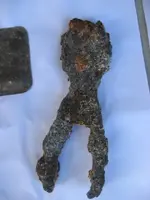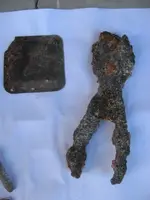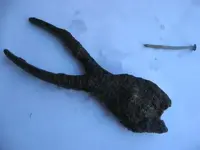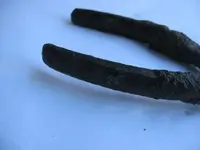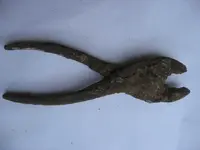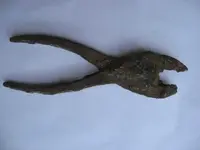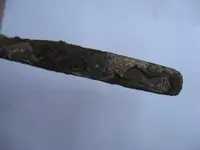Moe (fl) said:
Water is getting dirtier (rusty color). It has been running for over 24 hrs. What kind of fumes are released during the electrolysis process? The electrolysis tank is outside.
Hi Moe. Although I am not an expert about the fumes, to be simple about them, it is only oxygen and hydrogen, produced by the separation of the ions in water. But both of them are explosive, so better outside! During the process of electrolysis hydrogen bubbles are released and the chlorides are expelled from the metal. Some times sulfur fumes are created, you can smell that.
Here under find some tips that I want to tell you about, I hope you don't mind and can gain some information about electrolysis.
NOTE: Performing electrolysis can be dangerous: Noxious Fumes, Chemical Burns, Toxins/Poisonous Vapors, Splashing Chemicals and Electrical Shock so be CAREFUL! Much depends upon the electrolyte that you use, and the processes that
Some tips from me:
FIRST remember the words: Slow and Easy. That is the way to perform electrolysis!
Electrolytes :
Sodium hydroxide or lye (my favorite)
Calcium Carbonate
Soda Ash
Salt (my unfavorite)
Sodium bicarbonate
Oxygen will be created at the anode, so use anodes made of stainless steel because they will not react with the oxygen.
DO: If you use alligator clips to attach coins and soft materials to the cathode, file down the teeth, the can cause scratches! And don't mess around with the clips to increase the current, you can only make more scratches. Remove the object, carefully remove the clip, and replace it softly. But normally the current will increase most of the time gradually by itself. For coins and small objects I use as a tank a plastic take away container, when dirty just throw it away, it is hard and messy to clean glass or other reusable containers.
DO: Use something to fix the distance RELIABLY between the Anode (+) & Cathode (-) or Coin to be cleaned. If they get too close the current will rise and you could lose metal from your object or coin! If they touch, the power supply will short circuit which may damage the equipment or cause a fire (if you don't have a variable power supply).
DO: Use distilled water, I usually warm it up a bit I start, it makes the process start up quicker.
DO: Power Supply. Use a power supply, stabilized and variable, both voltage and current. I use one for small objects that has a range from 0-40V and 0-400ma, which is enough for all of my work so far. If not cleaned I just repeat until it is. But you can use other power supplies that deliver more current, but the important thing is to be able to adjust the voltage and current. I have found with difficult object, objects with much oxide on them, that I use first a higher voltage to break down the resistance, and after a few minutes the current begins to raise, then I control the current and voltage until the object is bubbling along just fine.
DO: Adjust the current down to the point the fizzing slows down and then bring it up high enough to do the job. Any higher current will just take metal away from the coin. Never go over 2 Amperes and try to stay under 1 Ampere (for small objects such as coins.)
DO: ANODE- I use stainless steel objects (mostly stainless steel forks and spoons that I find on the beach in the summertime, by beach resorts. Just save them and take them home). Actually most utensils are made of poor stainless steel, it would be better to use a high grade of stainless. The forks and spoons are attacked because of the impurities in the cheap metal. Be sure to change or cut off the bad part of the anode (stainless steel) when you change water, don't reuse it.... DO this every time you repeat the process. Oxygen will be created at the anode, so use anodes made of stainless steel because they will not react with the oxygen.
-DON'T: never leave a good coin alone with electrolysis !!!!! You will be sorry sooner or later.
-DO: Use distilled or rainwater or you may add minerals and impurities that can ruin your object. After electrolysis be sure to rinse the object. Also above the 30 volt level there is a SHOCK HAZARD, so be carefull, remember about the electrolyte!
-DO: Important! Before handling your object SHUT DOWN THE POWER SUPPLY!
DO: After some time the water will become warmer and the object will become covered in the remains of the oxide, not pretty for sure. Kitchen SALT can be used but gives the most awful remains! SHUT DOWN the power supply, remove the object and CAREFULLY clean it under running water if you can. Replace the water and replace or use a new part of the stainless steel anode. Then repeat if the object is not clean enough. To give you an example, using 25V and about 300ma I can usually get my silver coins clean in about 2 to 5 minutes, some I have to either leave in longer or increase the voltage or current. You DON'T have to use 5A to clean a coin, you will only destroy it.
DO: NOW, when you think you are done! You must rinse out the coin in clean distilled water then you MUST put new distilled water in a clean container and use a fresh Anode (+) Electrode and do it again WITHOUT the Electrolyte (sodium hydroxide or lye , Calcium Carbonate, Soda Ash, Salt, Sodium bicarbonate, or Sodium hydroxide). This step is essential to remove all traces of the electrolyte from the coin! You will have to turn the voltage up higher on your power supply just to get a little fizzing. This is normal as distilled water is not a great conductor. After adjusted for slight fizzing, you can let it sit for 7-12 hours (under supervision checks.)
These are only a few tips from me, there are many methods and everyone has their own personal way to do it. But just be careful!



